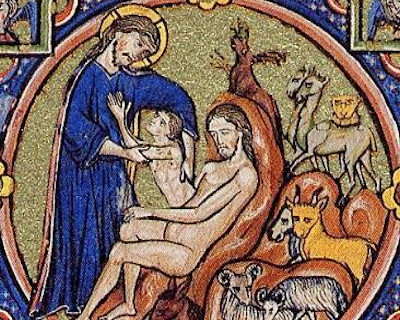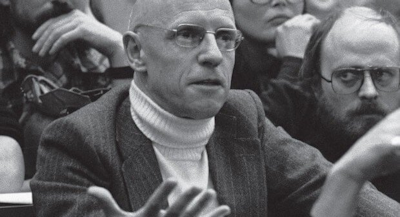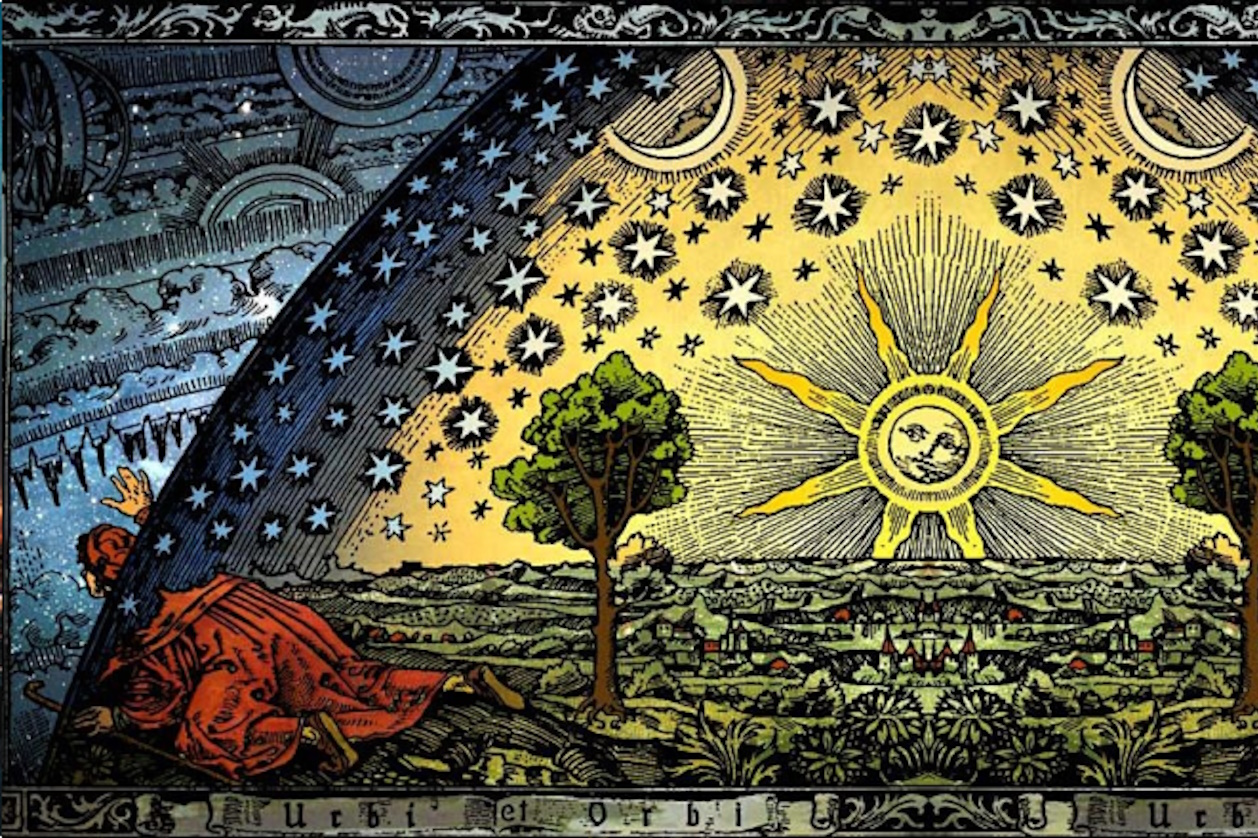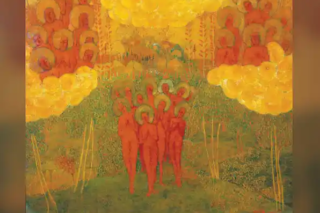In his presentation titled The Sleep of Adam, the Making of Eve: Sin and Creation in Eriugena,[*] Donald Duclow explores the gendering of humanity as related in John Scottus Eriugena's Periphyseon, with particular attention to some Eriugenian innovations on the theme.
In many ways Periphyseon draws on previous works including those of Gregory of Nyssa[1] and Maximus Confessor. Yet John embellishes these previous accounts in ways that are both novel and uniquely his own. What follows is a brief exploration of several key points in Duclow's presentation, followed by a couple of reflections regarding distinctive moments in Eriugena's work.
 In his account of the creation of humanity, Eriugena states that "the Divine History mentions but one Paradise and but one man created in it – though the one man includes both male and female, if the words of the Holy Fathers are to be followed" (Periphyseon, IV-833A).[2] Here Eriugena alludes to Gregory of Nyssa's explanation for the division of the sexes in his On the Making of Man.[3]
In his account of the creation of humanity, Eriugena states that "the Divine History mentions but one Paradise and but one man created in it – though the one man includes both male and female, if the words of the Holy Fathers are to be followed" (Periphyseon, IV-833A).[2] Here Eriugena alludes to Gregory of Nyssa's explanation for the division of the sexes in his On the Making of Man.[3]
In his original treatise, Gregory describes the challenge of his adversaries who suggested that if there had been no fall, there would have only been two humans: Adam and Eve. He counters that humanity was created in the image of God and was designed to multiply in the same (ineffable) manner as the angels.
However, the fall into sin brought the consequence of death to humanity, necessitating that God endow the species with another mechanism for procreation – one resembling the manner in which irrational animals reproduce – if humanity was to fulfill God's original plan to produce the full number of people that God intended (On the Making of Man, XVII). Thus in addition to the original imago dei imprinted on humanity, God went further to make humans as male and female.
While the division of the sexes is a result of humanity's fallen state for both Gregory and Eriugena, the latter breaks with traditional scriptural exegesis and redefines the moment at which this fall takes place.
Traditional interpretations of the Hexaemeron and the fall place the moment of transgression at the tempting of Eve by the serpent and the subsequent disobedience to God in the act of eating from the Tree of the Knowledge of Good and Evil in Genesis 3. However, Eriugena moves the moment of the fall to an earlier scriptural episode in the second creation narrative in Genesis 2 when Eve has yet to appear.
 In this account (the Yahwist variant) God creates the earth-man and breathes life into his nostrils to create a living being. God then, announcing that it is not good for the human to be alone, creates a succession of animals and brings them before the earth-man who names each of them. But no suitable mate is found for the human. So God causes a deep sleep to fall over Adam, removes one of Adam's ribs, and fashions a suitable partner for the first human. Adam calls her woman, as she is from man, bone of his bone and flesh of his flesh.
In this account (the Yahwist variant) God creates the earth-man and breathes life into his nostrils to create a living being. God then, announcing that it is not good for the human to be alone, creates a succession of animals and brings them before the earth-man who names each of them. But no suitable mate is found for the human. So God causes a deep sleep to fall over Adam, removes one of Adam's ribs, and fashions a suitable partner for the first human. Adam calls her woman, as she is from man, bone of his bone and flesh of his flesh.
Both Eriugena and his earlier sources agree that this is the point at which sexes appear within humanity. But in an unusual move, Eriugena reinterprets several key moments of the creation narrative.
First, Eriugena claims that when scripture states that God does something, this can often mean that God rather permits a thing (Periphyseon, IV, 835C). Having taken this step, he then suggests that rather than sending [issimus] sleep, God actually permits [permissus] the sleep to come upon Adam (ibid.).[4]
Eriugena further characterizes the sleep as "the deflection of the intention of the mind, which ought always and inflexibly to have been fixed upon its Creator," suggesting that the sleep is actually a turning of Adam's attention from contemplation of the Divine to "the delights of material objects" and more specifically, "the lust for carnal copulation" (Periphyseon, IV, 835C-835D).
Duclow suggests that Gregory of Nyssa's account of God's foreknowledge of the fall and the subsequent creation of the sexes and procreation as a means of achieving the original design gave Eriugena the insight that allowed him to come to his own reading of the creation of Eve. Where earlier Church Fathers had talked of a first human creation as νοῦς and a subsequent creation of the physical body or "garments of skin"[5] given to humanity as a good gift of God to aid in return to the original state, Eriugena instead proposes that it was the first human, dissatisfied with being created in the image of God, that created the first physical body. [Instructor Comment: Gregory speaks about the nous as imago Dei, and of the body as imago imaginis. Eriugena does adopt this. Maybe better: that provoked the creation of the first physical body? You are following Duclow, but I worry a bit whether he does not hypostasize the reading of Eriugena here.]
"Man whom we have made to our image and likeness does not think it good to be alone, that is, to be simple and perfect nature abiding everywhere without the division of his nature into sexes, being wholly like the angelic nature, but prefers to tumble down headlong into earthly couplings likes beasts…" (Periphyseon, IV, 846B-C)
However, in line with his sources, Eriugena also believes that the mortal condition and its attendant degradations will chasten humanity:
"…and by punishment [man will] be brought to repentance and seek in a chastened mood, by getting to know himself again and by mortifying himself, to return to the first state of his nature…" (Periphyseon, II, 583C).
Eriugena also departs from the traditional reading of the Genesis creation account in another significant way: in the same way that God permits the trance to come upon Adam in which Adam turns from his contemplation of the Divine, so also does God permit the human to create the material human body.
If the first moment of God's permissive will was somehow within the realm of possibility based on Eriugena's hermeneutic of "permitting" amounting to divine action, this second innovation clearly contradicts the text of the Genesis 2 creation account that in explicit, anthropomorphic terms details how God acts as agent. It is God who forms the human from the dust of the ground and breathes into the human's nostrils. Here the application of the same hermeneutical rule to claim that God permitted the first human these actions seems more strained and less plausible than the first permissive (non-)act.
In his presentation Duclow suggests that Eriugena avoids references to Augustine, whose theological treatises do not align with the Irishman's novel interpretation. However, the Teacher does address what appear to be inconsistencies between Gregory the Theologian [sic] and Augustine.
Rather than choosing one authority over the other, Eriugena seeks to harmonize their accounts, claiming that Augustine's references to the corporeal body were analogous to the second creation of humanity in Gregory. Augustine, he tells us, simply never wrote about the first creation, focusing in his own works only on the latter (Periphyseon IV, 804C-805B). [Instructor Comment: Indeed, good points.]
Finally, an area of personal interest for me is Eriugena's interpretation of Maximus's cosmic schema of five divisions and reunifications in the restoration of the world. The last of these divisions – humanity's division into male and female – is according to Maximus the first to be overcome in Christ.
Following the early baptismal formula found in Galatians 3:28, we find that in Christ there is no Jew or Greek, no slave or free, no male and female.[6] Maximus and Eriugena both follow the model of earlier theologians like Irenaeus who continued to expand on Paul's parallels between Adam and the "new Adam" of Christ, identifying symmetries in the stories of the Old and New Testaments.

Duclow's illustrations from the Bible moralisée drove this point home, depicting the rib being removed from Adam's side to form Eve in juxtaposition to the image of blood flowing from the side of the crucified Christ which would form the Church, the Bride of Christ.[7]
Following this familiar exegetical model, Maximus sees a parallel between the first Adam who was created without human procreation from the dust of the ground and the virgin birth of Jesus. But Maximus suggests that the virgin birth has another meaning as well:
"In this way he showed, I think, that there was perhaps another way, foreknown by God, for human beings to increase, if the first human being had kept the commandment and not cast himself down to an animal state by abusing his own proper powers" (Ambiguum 41, 1309A).[8]
While all of humanity from Cain and Abel forward are begotten as the result of an irrational and animal copulation, Jesus comes into the world as a new creation brought forth from the virgin soil of Mary's womb (Ambiguum 42, 1325A).[9]
But the virgin birth accomplishes something even more important to Maximus's plan of recapitulation:
"Thus God-made-man has done away with the difference and division of nature into male and female, which human nature in no way needed for generation, as some hold, and without which it would perhaps have been possible. There was no necessity for these things to have lasted forever" (Ambiguum 41, 1309A).
For Maximus the sole purpose for the division of humanity into male and female was the generation of further humans in the face of bodily corruption and mortality, but with the incarnation of the Logos, this seeming necessity was overcome. [Instructor Comment: I think that this I already Gregory’s reasoning behind his advocacy of virginity, say, in his Treatise on Virginity. But Eriugena did not know that treatise I believe.]
However, for Eriugena the abrogation of male and female occurs not in the birth of Christ, but rather in his resurrection. In Periphyseon II, 537D-538A he writes,
"… the Lord Jesus united in himself the division of (our) nature, that is male and female. For it was not in the bodily sex but simply in man that He rose from the dead. For in Him there is neither male nor female although it was in that masculine sex in which He was born of a Virgin and in which He suffered that he appeared to His disciples after His resurrection… For otherwise they would not recognize Him if they did not see the shape that was known to them" (emphasis in original).
This description raises two interesting moments for further exploration. First, the idea of Christ appearing to his disciples as a male though he was no longer such (but rather had become the reunification of male and female in the original Adamic form) feels dangerously close to Docetism, in which Christ only seems or appears to others as something that he actually is not. This is a relatively minor point; however, I felt it worth mentioning and potentially worth further consideration. [Instructor Comment: I think it is indeed minor, for the whole point of Docetism is to have Christ appearing in his life and not undergo suffering and death. This would only apply to resurrection, where according to Paul we have a more ethereal body.]
Second, Eriugena could have just as easily pointed to Mary's misapprehension of Jesus as the gardener at the tomb (John 20:15) or Cleopas's characterization of Jesus as a stranger in Jerusalem on the road to Emmaus (Luke 24:13-32) as examples of how the resurrected Christ was no longer recognizable as the man that he had been only days before. [Instructor Comment: Indeed, he could have done so.]
Finally, I found this presentation particularly interesting for my own project. In his conclusion, Duclow points to the discomfort experienced by many at the contemplation of a future world without sexual division. Eriugena uses the Student in his text to give voice to their apprehension:
"For who is there who, hearing such things, would not be horrified and at once break out in these words: 'Then after the resurrection there will be no sexual division of male [and] female if each is to be totally removed from human nature? Or what form will appear in man if no one has either male or female form? Or what sort of recognition will there be if there is to be an extermination of both sexes and an amalgam of all men, whether spiritual and incorporeal or visible and corporeal (and) circumscribed by place and time, into a simple unification, not divided by difference of forms?'" (Periphyseon, II, 543A, emphasis in the original).
 My own interests in queer theory and apophatic theology have led me to begin an exploration of a theological anthropology that takes seriously the notions found in Galatians 3:28 where divisions of ethnicity, socioeconomic class, and even gender are said to be absent in Christ.
My own interests in queer theory and apophatic theology have led me to begin an exploration of a theological anthropology that takes seriously the notions found in Galatians 3:28 where divisions of ethnicity, socioeconomic class, and even gender are said to be absent in Christ.
The horror expressed by Eriugena's Student is a common reaction even today when people are exposed to the idea that much of what we consider to be male or female is not innate, but rather socially constructed.
According to Gregory, Maximus, and even Eriugena, the original imago dei does not include the second half of Genesis 1:27. It would seem that a further exploration of their texts could prove quite useful.
[*] Professor Duclow's presentation was delivered at the Eriugena and Creation conference at UChicago Divinity School in November 2011.
[1] Eriugena in several places appears to conflate Gregory of Nyssa with Gregory the Theologian (or Nazianzus).
[2] Citations are from the Periphyseon (The Division of Nature), translated to English by I. P. Sheldon-Williams and revised by John J. O'Meara, in Periphyseon (The Division of Nature) (Montréal: Éditions Bellarmin; Washington, DC: Dumbarton Oaks), 1987.
[3] Citations from this work come from the translation by H. A. Wilson of From Nicene and Post-Nicene Fathers, Second Series, Vol. 5. Edited by Philip Schaff and Henry Wace. (Buffalo, NY: Christian Literature Publishing Co., 1893.) Revised and edited for New Advent by Kevin Knight. <http://www.newadvent.org/fathers/2914.htm>.
[4] I am indebted to Prof. Duclow for his generosity in sharing his manuscript for the Latin insertions which I could not have isolated myself without great difficulty.
[5] A discussion of the garments of skin can be found in From Glory to Glory: Texts from Gregory of Nyssa's Mystical Writings by Jean Danielou (Yonkers, New York: Saint Vladimir's Seminary Press), 1997, pp. 11-13.
[6] οὐκ ἔνι ἄρσεν καὶ θῆλυ, includes a καί construction (rather than the οὐκ … οὐδέ construction used in the other two distinctions), as well as the word choices of Genesis 1:27, providing a clear intertextual reference to the Creation narrative.
[7] Eriugena also plays on this particular image of recapitulation in Periphyseon IV, 836D-837A, where he expands on Augustine's reference to the sacraments that flow from the side of the pierced Christ to form the Church and then adds that the "tunics of skin" in which the Church (foreshadowed by Eve) is clothed will be removed by the Second Man, Christ.
[8] See Maximus the Confessor by Andrew Louth (New York: Routledge), 1996.
[9] See On the Cosmic Mystery of Christ by St. Maximus the Confessor (Crestwood: Saint Vladimir's Seminary Press), 2003.
[Instructor Comment: Very good job and considerate reflection. You may indeed work with some of these materials. I think the Docetism charge is fairly easy to dismiss, and there may be materials in here for your project. I will be glad to be of assistance in some form.]




